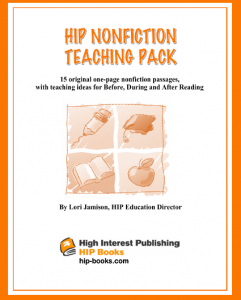*FREE WITH PURCHASE!* THE HIP NONFICTION TEACHING PACKAGE
15 original one-page nonfiction passages with ready-to-teach lesson plans
66 pages of student reading passages and teaching tips for Before-, During- and After-Reading
Created by Lori Jamison Rog, author of Struggling Readers: Why Worksheets Don’t Work and Band-aids Don’t Stick
Everything you need for online, independent or teacher-directed learning
View the Table of Contents.
*Not available for sale. Complimentary on request with HIP orders over $200, as our thanks for your patronage.
TEACHING PACKAGE
The passages in the HIP NONFICTION TEACHING PACKAGE are designed for independent, online or teacher-directed learning. Each passage includes a Before-, During- and After-Reading routine, most of which are adaptable to almost any nonfiction text. They are most effective as practice opportunities to accompany explicit teaching.
Before-Reading Routines
What readers do before starting to read can make a big difference to how well they comprehends a text. Adequate background knowledge makes a huge difference; in fact, it’s been suggested that background knowledge represents over 60% of comprehension. The Before-Reading routines in this collection include video links, anticipation guides, vocabulary sorts and more to prepare the reader for reading the passages.
During-Reading Routines
It’s particularly important for struggling readers to learn to “read actively.” The During-Reading suggestions often set a purpose for reading; for example, read to see if your predictions were right or read to see which facts you already knew and which you learned.
After-Reading Routines
Each passage includes two types of after-reading routines: questions for discussion and some form of written response.
Writing is the single best tool we have for supporting comprehension and retention of information. In these after-reading routines, students are given a range of written response tasks from completing graphic organizers to chunking complex words and sentences to creating original stories and arguments.
Get more ideas for helping students NAVIGATE NONFICTION here.


